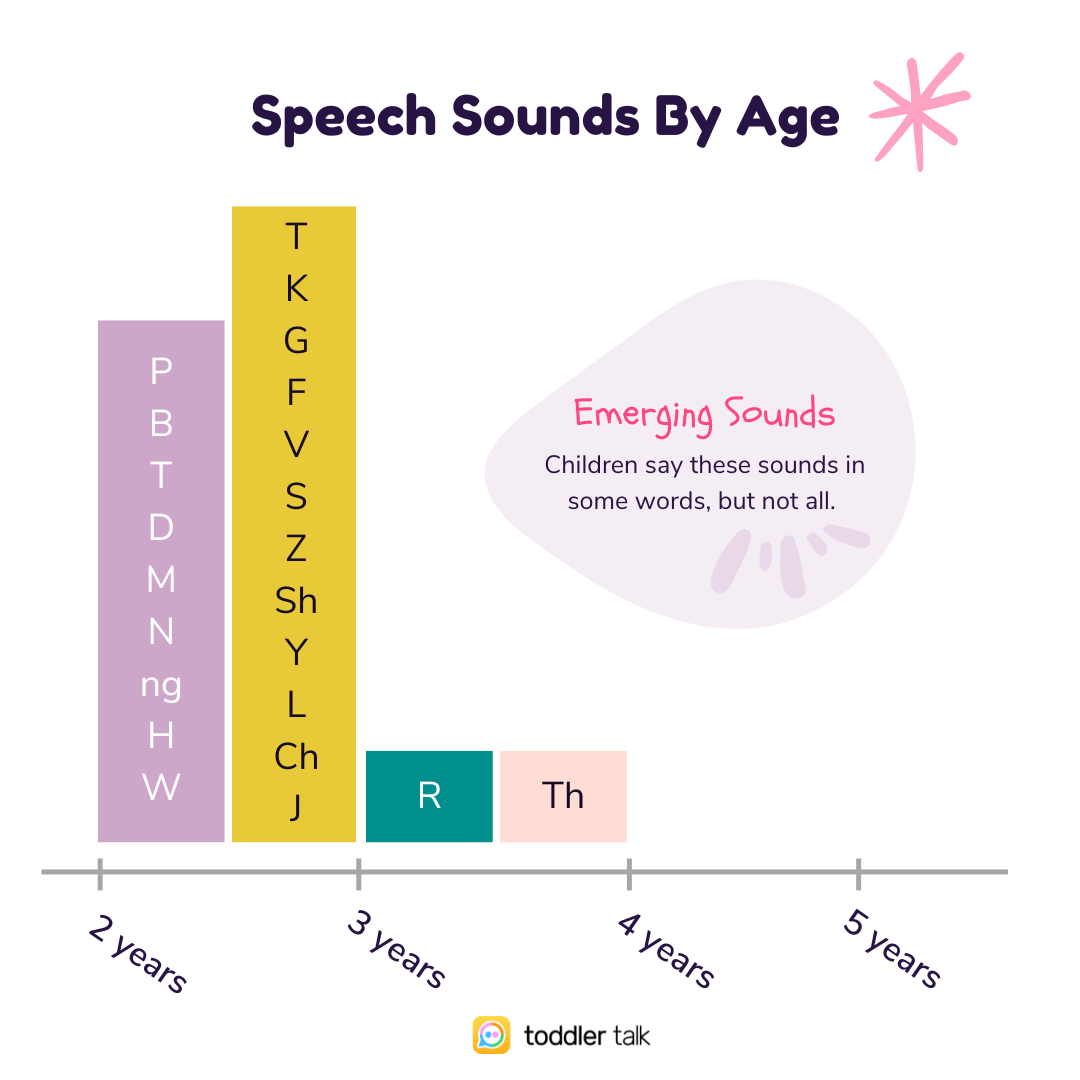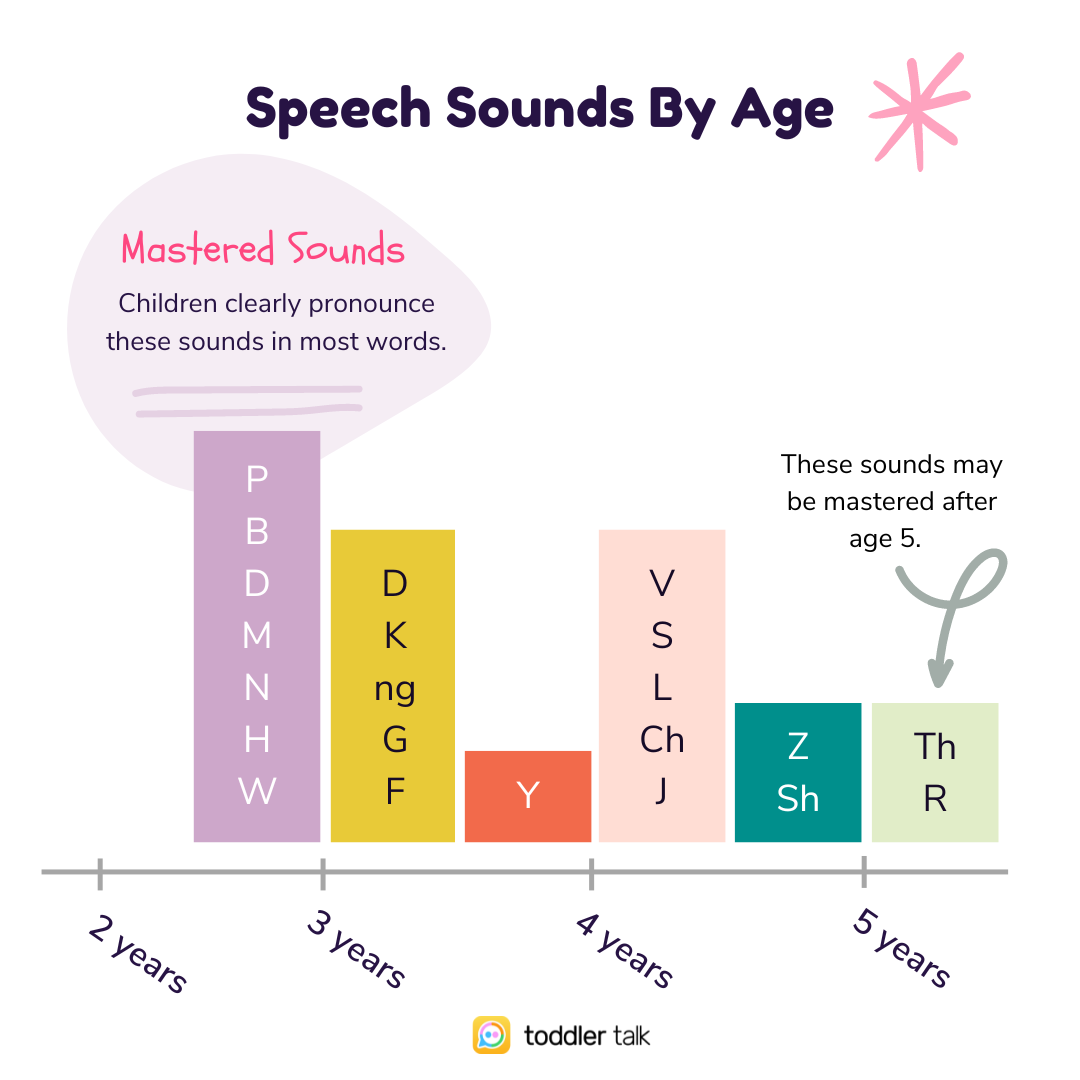Articulation Norms By Age + Articulation Disorders
An articulation disorder is one of the most common reasons why it might be hard to understand what a child is saying and one of the most common reasons children go to speech therapy. An articulation disorder happens when children do not clearly pronounce a set of specific sounds.
In this post we’ll cover:
What is articulation?
Articulation refers to the movement of parts together.
When we are talking about speech, the word “articulation” is referencing how specific sounds are made in the mouth, or the movement of all the parts of your mouth and airway together to make sounds and pronounce different words.
Speech requires coordination between the lips, teeth, tongue, jaw, palate (roof of your mouth), cheeks, vocal cords, and lungs (breath control).
In English there are 26 written letters, but there are actually about 44 different sounds because some letters represent more than one sound. That’s a lot of sounds for your little one to learn!
What are articulation norms?
Articulation norms are used to determine what age most children can pronounce different sounds. Articulation norms come from research studies; the norms we provide below come from the most recent research study completed by Kate Crowe and Sharynne McLeod in 2020 (read the complete article here).
Speech Sounds By Age Chart
Before sharing the Speech Sounds By Age Chart I think it’s important to mention that this chart cannot be used to diagnose or rule out an articulation disorder. I will explain more about why after we review the chart.
Toddler Talk’s Speech Sounds By Age chart will explain when the research shows specific consonant sounds are emerging - or when toddlers can use the sounds in some words. And we’ll also show the age at which speech sounds are mastered - or when toddlers can pronounce specific sounds clearly in most words. It's important to note that the this table shows the sounds and ages of mastery for kids who only speak English in the United States.
This chart should make it clear that when a two and a half year old says "wabbit" instead of rabbit, that it's perfectly normal. We expect the error at this age because children don't master the R sound until age five.
When children leave off a sound or substitute a sound they can’t say yet for one they can, we call these types of errors developmental errors. They are normal or expected errors within a child's development and typically improve with age and skill advancement. These expected errors do not warrant speech therapy. Whereas, unexpected errors might.
Note: If your child speaks a language other than English (including bilingual children) or you live outside the United States, the age of mastery for each sound may be different. However, another study by Crowe and McLeod (2018) showed that children learning 27 different language all learned most consonant sounds at about the same age, although there is some variability. In general, they found that kids around the world develop most consonant sounds by the time they turn 5 (60 months).
Why you can’t just look at the Speech Sounds By Age Chart
If you are wondering if your child may have an articulation disorder I want to assure you that we can’t diagnose or rule out errors with articulation just based on the norms chart. The biggest issue with looking only at a norms chart is that speech development is much more complex than simply what sounds your child is making and there are so many different factors influencing their development. This is where a speech therapy evaluation is invaluable!
Children can qualify for articulation therapy to learn the pronunciation of sounds even if they are younger than the ages mentioned in the chart. A speech therapist may determine that therapy is appropriate depending on why it’s hard for your child to say that sound, rather than simply focusing on the specific sounds they can pronounce. Many times starting therapy earlier can reduce the overall amount of time kids spend in speech therapy because it’s easier to address articulation issues in their earliest stage, before hard to change articulation habits are formed.
Regardless of your child’s age, you should seek the support their pediatrician and a speech therapist if you have concerns about your child’s speech development. There are other factors, such as intelligibility, to consider when deciding if a child needs speech therapy.
Errors in articulation
Remember, learning all 44 sounds in the English language is a big task so do your best not to worry as your child develops their speech. Each sound requires that they first think of a sound to make, then move all of their mouth and their throat muscles in a perfectly timed pattern to articulate it. It's a lot of work. Combining sounds together into words and words together into sentences makes it even more complicated. And your child is bound to make mistakes. Mastery of each new skill will take time and practice.
So be patient and celebrate each little step along the way! And always talk to your child’s pediatrician or a speech therapist if your mom gut tells you something’s not quite right.
What is an articulation disorder?
Speech-language pathologists (SLP) usually say that a child has an articulation disorder if they only have a few sounds in error.
Errors with “articulation” are errors with consonant sounds and the error is typically incorrect placement and/or movement of the tongue.
What are some common articulation disorders in children?
There are some common articulation errors that speech therapists frequently treat.
When a child lisps the sounds “S” and “Z” this is considered an articulation error because their tongue is in the incorrect place (More on lisps in a bit).
In addition to issues with articulation for the “S” and “Z” sound, speech therapists also often treat articulation disorders including the “R” “TH” “K” and “G” sounds.
A preschooler may not know where to put their tongue for “K” and “G” and the SLP can teach them that. Similarly an elementary school student may still replace the “R” sound with “W” and a speech therapist can help the student learn how to move their tongue to pronounce “R.”
If a child has lots of sounds in error, the therapist is less likely to classify it as an articulation error. Instead, they might see that there is an error with an entire category of sounds, making them suspect a phonological disorder or a motor speech disorder, such as childhood apraxia of speech, depending on the type of error patterns they see.
How do I know if my child has problems with articulation?
First, remember that children don’t develop all their sounds at the same time and it is normal for certain sounds to be missing or said incorrectly while they are young. Refer to this chart to see when expected sound development takes place. If your child is making a sound incorrectly that they should have mastered by now, an articulation problem might be suspected.
If your child is older and missing sounds or says the sounds wrong, you might consider asking the school speech therapist to test their speech. If your child is not in school, you can go through your insurance for testing.
A speech therapist will listen to your child’s speech to look for patterns, listen for the sounds they can pronounce, and identify the sounds that are hard for them to produce. The speech therapist will also administer a standardized test which is used to qualify for insurance coverage of speech therapy to treat an articulation disorder. The most commonly used test is the Goldman Fristoe Test of Articulation which requires children to name a series of pictures as the speech therapist listen for specific errors in pronunciation.
Related Reading: How to find a speech therapist near me
Is articulation the same as apraxia?
Articulation is not the same as apraxia. Errors with articulation involve the tongue and only a few sounds. The sounds are produced incorrectly in all words and in all places in the word. In speech therapy, “articulation” generally refers to consonant sounds.
In contrast, apraxia is a motor speech disorder that includes imprecise movement of the tongue as well as the lips and jaw. Many sounds are impacted, including vowel sounds. Errors might be inconsistent and dependent on what other sounds are present in a word.
The distinction between articulation and apraxia is important because they are treated differently in therapy. Articulation therapy involves coaching a child to place their tongue in a specific place, and then practicing that sound in different words. Apraxia therapy will target coordination of all the parts of the mouth together.
Sometimes a child with apraxia might have articulation errors as well that require coaching before they are integrated into overall apraxia treatment.
Related Reading: What is childhood apraxia of speech?
What is a lisp?
A lisp is a particular error made when a child (or adult) places their tongue in between their teeth creating a “th” or lisp sound, instead of placing their tongue behind their teeth to pronounce a “s” or “z” sound.
I heard that sometimes lisps don’t need to be treated, is that true?
When people say “lisp” they mean that a person makes the sounds “S” and “Z” incorrectly in the mouth. There are actually two types of lisps:
In the first kind, the child puts their tongue between their front teeth. This lisp sounds sort of like a “th” sound. This is a normal pattern for kids and it often corrects itself. I don’t treat this kind of lisp until the child is at least 7 years old. This kind of lisp requires treatment if it doesn’t correct itself by the end of first grade or if it is caused by a tongue thrust (see below).
The second kind of lisp is when a person pushes their tongue to touch their teeth on the side of their mouth, called a lateral lisp. If you meet an adult with a lisp, chances are they have this kind of lisp. That’s because lateral lisps don’t correct themselves and always need treatment. I will start treating a lateral lisp earlier than the other kind as long as the child is mature enough to participate in the therapy.
What causes an articulation disorder?
In most cases, articulation issues just happen and there is no “cause.”
There are, however, a few instances where I can point to a specific cause:
Pacifier Use
If kids use pacifiers too long, sometimes they will start to try to “talk around” the pacifier and turn that into a bad habit. This means that sounds they need the tip of their tongue for might be distorted or missing. These kids might have issues with “T”, “D”, “S”, “Z” and/or “N.”
Tongue Thrust
Sometimes when kids lisp, they put their tongue between their front teeth. But it is possible that they push their tongue forward when they make other sounds too, including “T”, “D”, “N”, “CH”, and/ or “SH.” Kids with a tongue thrust speech pattern usually have this because they have a tongue thrust swallow pattern. Yes, I know I just got super technical. Tongue thrusts can develop when a child uses bottles/ pacifiers/ spouted sippy cups or suck their thumbs too long. This type of articulation error is best treated by having a speech therapist who knows how to treat the swallow pattern address the swallow and then correct the placement of the other sound/s after.
Dental Issues
I have met kids who have developed articulation issues due to extreme overbites/ underbites. It is another instance of a habit being formed when attempting to “talk around” something in the mouth. In my experience, once the dental issues are corrected the kids can start to speak normally, either on their own or with brief speech therapy.
How common is an articulation disorder in kids?
Articulation issues in kids are very common. I would bet money that in any given kindergarten-second grade class there are multiple kids with articulation challenges. When I became a speech therapist, countless adults I know came to me and confessed that they had seen a speech therapist at some point to correct a lisp or a distorted R sound.
Key Points to Remember:
An articulation disorder happens when they are consonant sounds are pronounced incorrectly because of incorrect movement and/or placement of the tongue.
Articulation disorders can be cause by pacifier use, tongue thrust, or dental issues
Articulation disorders are common; they are treated in preschool and elementary school predominantly
Suggested Next Reads:
Speech Intelligibility and how speech therapists use it to track articulation development
See all of our free lessons about toddler speech development
References:
Crowe, Kate ; McLeod, Sharynne. / Children's English consonant acquisition in the United States : A review. In: American Journal of Speech-Language Pathology. 2020 ; Vol. 29, No. 4. pp. 2155-2169.
McLeod S, Crowe K. Children's Consonant Acquisition in 27 Languages: A Cross-Linguistic Review. Am J Speech Lang Pathol. 2018 Nov 21;27(4):1546-1571. doi: 10.1044/2018_AJSLP-17-0100. PMID: 30177993.
Written by: Stephanie Burgener-Vader, MA, CCC-SLP and Stephanie Keffer, MS, CCC-SLP
© 2020-2025. Stephanie Keffer Hatleli, MS CCC-SLP. All Rights Reserved.
The content offered on ToddlerTalk.com is for informational purposes only. Toddler Talk is not engaged in rendering professional advice, whether medical or otherwise, to individual users or their children or families. No content on this site, regardless of date, should ever be used as a substitute for direct medical advice from your doctor, speech language pathologist, or other health professional. By accessing the content on ToddlerTalk.com, you acknowledge and agree that you are accepting the responsibility for your child’s health and well-being. In return for providing you with information related to home speech and language practice, you waive any claims that you or your child may have as a result of utilizing the content on ToddlerTalk.com.







